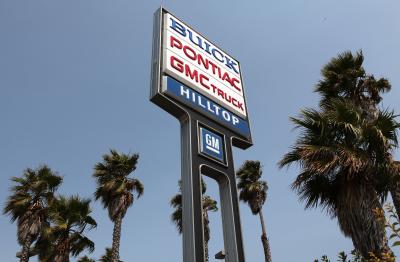
Buick vehicles all come with front disc brakes that integrate calipers, pads and rotors. Some of the newer front-wheel drive models may also feature rear disc brakes instead of drum brakes. While replacing calipers is not a common brake repair, it is required to remove them in order to replace pads or rotors. The rear calipers on Buicks integrate the parking brake cable. Because of this, there is a slightly different procedure install them than the front calipers.
Remove the hubcap(s) if applicable and loosen the lug nuts with a tire iron before lifting the wheel(s) you intend to install the caliper on.
Raise and support the wheel(s) of the Buick with a jack and jack stands and then remove the lug nuts and wheels.
Place the C-clamp over the back of the caliper housing and the drive of the clamp onto the backing plate of the outboard pad. Tighten the clamp to compress the caliper piston.
Pull down on the parking brake cable (on the rear calipers only) and then remove the cable from the cable connector on the caliper.
Place a drain pan below the wheel where the brake hose attaches to the caliper.
Place a brake hose clamp onto the brake hose just a few inches away from where it connects to the caliper.
Remove the brake hose bolt from the caliper using a ratchet and socket or a box-end wrench. Be sure to remove the old copper washers from both sides of the brake hose bolt.
Remove the two caliper guide bolts with a ratchet and socket or a box-end wrench (front calipers only). Remove just the lower bolt on rear calipers and then pivot the caliper upward to slide it off the upper caliper pin bolt.
Remove the caliper anchor bolts if desired. Some replacement calipers come with the caliper anchors while other do not. Only remove the anchor if you're replacing the anchor or the rotor.
Install the new caliper by reversing the procedure. New calipers will come with the pistons compressed. Be sure to replace the copper washers on each side of the brake hose bolt and reattach the parking brake cable to the rear calipers
Open the bleeder screw of the new caliper until a steady trickle of brake fluid begins to purge from it. Be sure to align the drain pan to catch the fluid. Remove the master cylinder cover and check the fluid often so it does not run out of fluid. When a steady trickle is achieved, tighten the bleeder screw, top off the master cylinder with new brake fluid and then replace the cover.
Employ an assistant to carefully get into the Buick and pump the brake pedal four to five times. While the assistant is holding pressure down on the brake pedal, reopen the bleeder screw to purge the air from the brake lines. Repeat this procedure until the brake pedal feels firm and the brake fluid lacks air bubbles. Top off the master cylinder with new brake fluid again and then replace the wheel and lug nuts.